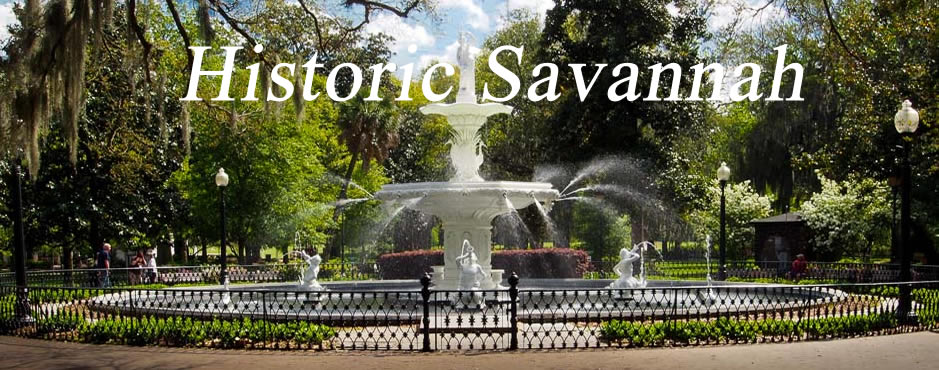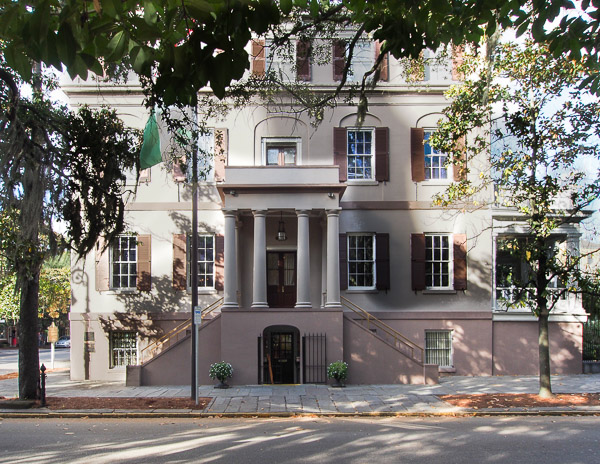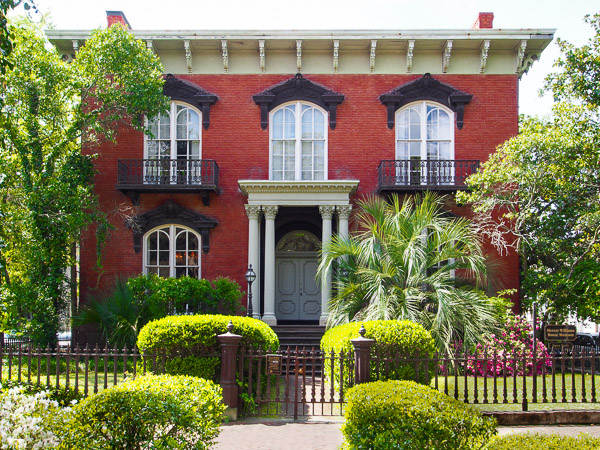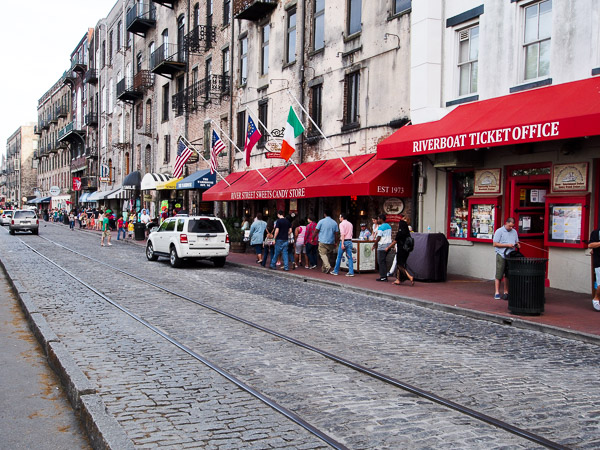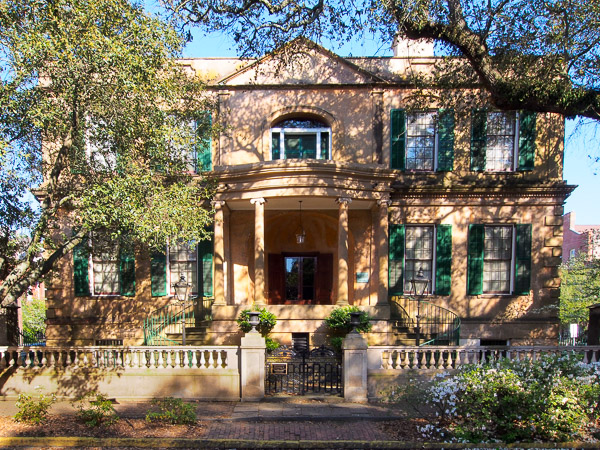- - - - - - - - - - - - - - - - - - - - - - - - - - - - - - -
5) Juliette Gordon Low Birthplace
10 East Oglethorpe Avenue (One Block South of Wright Square)
(912) 233-4501
Juliette Gordon Low Birthplace was originally built between 1818-1820 for Savannah mayor James Moore Wayne. In 1831 he sold the house to his niece, Sarah Stiles and her husband William Washington Gordon I. Gordon was the grandfather of Juliette Gordon Low and he was the founder of the Central of Georgia Railway. Juliette Gordon Low, founder of the Girl Scouts, was born in this house on Halloween in 1860. Juliette, known as Daisy, married William Low and moved into the Low family home on Lafayette Square.
In 1953 the Girl Scouts purchased the Gordon family home. The home has been restored and furnished with many original family pieces. The house was opened as a historic house museum in 1956.
Time to spend: 1 - 2 hours
Hours: March thru October
Monday - Saturday: 10:00a - 4:00p
Sunday: 11:00a - 4:00p
Hours: November thru February
Monday, Tuesday, Thursday - Saturday: 10:00a - 4:00p
Sunday: 11:00a - 4:00p
- - - - - - - - - - - - - - - - - - - - - - - - - - - - - - -
6) Mercer-Williams House
430 Whitaker Street (Monterey Square)
(912) 236-6352
Once home to lyricist Johnny Mercer, this house is much more famous for its other resident, Jim Williams, a noted Savannah antiques dealer and the central character in John Berendt's best-selling book "Midnight in the Garden of Good and Evil."
The construction of the house began in 1860 by Hugh Mercer but was postponed because of the Civil War. The house was later sold to John Wilder who completed the construction in 1868.
Jim Williams bought the house in 1969 and began a 2-year renovation of the run-down property. The elegant Italianate red brick mansion with tall arched windows and ornate ironwork balconies is considered one of the most beautiful in all Savannah. The house is filled with 18th century portraits and beautiful antique furnishings from Jim William's private collection. You can tour the first floor of the house but the second floor is not open to the public.
Time to spend: 1 - 2 hours
Tours:
Monday - Saturday: 10:30a - 3:40p
Sunday 12:30p - 4:00p
Note: Winter hours will vary. Call (912) 236-6352
- - - - - - - - - - - - - - - - - - - - - - - - - - - - - - -
7) River Street
Historic River Street is a fascinating and must see area to visit. River Street was once the site of a bustling cotton industry with many warehouses to store the cotton. Today River Street is a bustling area for both tourists and locals.
River Street is a nine block of renovated old cotton warehouses which now house restaurants, pubs, night spots, shops, galleries, open-air marketplace and boutiques. The stone ramps that connect Bay Street with River Street are made of the English ballast stones which gave schooners added stability for their trips from Europe. These discarded stones were also used to pave River Street.
River Street is a great place to people watch or just sit, relax and watch the huge container ships go by. You can also be entertained by some of the local musicians.
There are plenty restaurants to choose from as well as shops for treats. Stop by River Street Sweets for a sample of the best homemade pralines in the south. There are several pubs who feature live entertainment each night. Don''t forget shopping. River Street has several boutiques, art galleries, and other specialty shops.
Time to spend: 4 hours to entire day
- - - - - - - - - - - - - - - - - - - - - - - - - - - - - - -
8) Bonaventure Cemetery
330 Bonaventure Road
Thunderbolt, Ga, 31404
Bonaventure Cemetery is over 170 years old and covers 160 acres. It is one of the world's most beautiful cemeteries. There are many elaborate headstones and mausoleums. Also, there are many unusual tombstones and one of the most unique is in the shape of a piano. The interesting tombstones and vaults, the colorful camellias and azaleas, and the wonderful old live oak, dogwood and magnolia trees have made the cemetery one of the most photographed in the country.
Many of Savannah's statesmen, citizens and soldiers are buried in Bonaventure Cemetery in the shade of 250-year-old moss-laden oak trees. Savannah founders Noble Wimberly Jones and Edward Telfair are buried here along with some prominent Civil War Generals. In more recent years, famous Savannah celebrities laid to rest in Bonaventure include singer and lyricist Johnny Mercer and poet Conrad Aiken.
Time to spend: 4 hours to entire day
Hours: Daily 8:00a - 5:00p
- - - - - - - - - - - - - - - - - - - - - - - - - - - - - - -
9) Owens-Thomas House & Slave Quarters
124 Abercorn Street (Oglethorpe Square)
(912) 790-8800
The Owens-Thomas House & Slave Quarters is considered by architectural historians to be one of the finest examples of English Regency architecture in America. This most important and architecturally significant house was begun in 1816 and completed in 1819.
The Owens-Thomas House & Slave Quarters occupies a full block. The home features a columned entrance portico, handsome cast iron balcony, winding double stairway, and arched second story windows. The interior has a magnificent stairway of mahogany, cast iron and brass and elegant furnishings. The foundation of the home and garden walls is built of tabby, a regional material made of sand, shells and lime.
The Owens-Thomas House & Slave Quarters collection contains furnishings and decorative arts from the English Regency period; most pieces dating from the years 1790 to 1840. Collections include English Georgian and American Federal period furniture, early Savannah textiles, silver, Chinese Export porcelain, and 18th- and 19th-century art. The courtyard features a small parterre garden.
The north half of the building contains the original slave quarters. The two-story building had three rooms on each level. Nine to fifteen people including children lived and worked on the site between 1819 and the end of the Civil War. After the war ended the space became the servants' quarters. The house-servant's quarters feature slave artifacts of the period.
Time to spend: 1 - 2 hours
Tours run every 20 minutes:
Duration of the tour is 45 minutes
Sunday - Monday 12:00p - 5:00p
Tuesday - Saturday 10:00a - 5:00p
Last tour is at 4:20p
